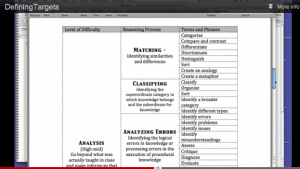Be Reasonable!
CompetencyWorks Blog
Defining Targets With Reason
 In an earlier post I talked about what a learning target is, and how to write one. Whenever I run a PD session about learning targets, someone points out that it is difficult, if not impossible, to measure “being skilled at” or “understanding.” I am sure some of you were left with that same sentiment after reading Target Practice.
In an earlier post I talked about what a learning target is, and how to write one. Whenever I run a PD session about learning targets, someone points out that it is difficult, if not impossible, to measure “being skilled at” or “understanding.” I am sure some of you were left with that same sentiment after reading Target Practice.
You know what? You are right! A learning target on its own is not enough. A target needs to be defined in terms of reasoning levels and foundational knowledge. Without doing so, we are in danger of pontificating on and on about what it means to understand… and setting a college level bar for our sixth graders! Here is a step-by-step on how to set an appropriate reasoning level for a learning target. This video shows me working through the process.
1. Select a target
You may already have a set of targets, or you can create them based on your current standards.
2. Think about what you want students to do in order to show you that they “get” it
You already do this. We’re just making the process transparent so that we can be more precise in our measurement of targets. Think about what you have had students do in the past. Keep in mind their age and developmental stage. Consider what is reasonable and realistic. Take into account where they came from in their learning, and where they are headed.
3. Select a reasoning level from the Marzano-Bloom’s Taxonomy chart
The reasoning levels are organized in a continuum of simple to complex. Retrieval is the lowest of the reasoning levels. Knowledge Utilization is the highest. This chart was originally created at SAD 57, and is based on Marzano’ and Kendall’s 2007 work around The New Taxonomy. You can find The New Taxonomy as a pdf here. Or go to Marzano Research Laboratory for more information.
4. Select a reasoning process
The reasoning process helps to specify the kind of tasks students can do to demonstrate a skill or an understanding. Use the phrases in the far right of the chart as sentence starters for assessment tasks. You can even create multiple assessments for students to choose from. The key point is that all of the assessment options are at the same reasoning level.
5. Define the foundational knowledge for your target
Foundational knowledge are the pieces, or steps, of the target that are essential for meeting the target, but on their own do not demonstrate meeting the target. They are assessed at a reasoning level lower on the Taxonomy than your actual target is.
Below is an example of a target used in our middle school. This is the same target I walk through defining in the video. This target is not one used in our regular science classes; rather it is a target used in one of our more experiential-learning focused programs. I don’t even begin to pretend to be an expert at any one particular content area, so feel free to help us improve our thinking!
|
Target |
Reasoning Level | Assessment Task |
| Understands how scientific nomenclature is used in the scientific community | Analysis(Matching) | Compare and contrast the scientific and common naming systems used for identifying a particular species |
| Foundational Knowledge:Knows the terms: nomenclature, scientific, classifyKnows the levels of scientific nomenclatureKnows how to use a field guideKnows how to classify a species using scientific nomenclature | ||